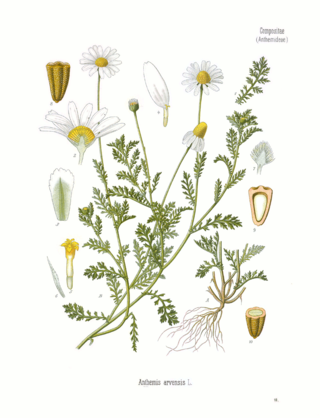
The Agricultural Research Service (ARS) is the principal in-house research agency of the United States Department of Agriculture (USDA). ARS is one of four agencies in USDA's Research, Education and Economics mission area. ARS is charged with extending the nation's scientific knowledge and solving agricultural problems through its four national program areas: nutrition, food safety and quality; animal production and protection; natural resources and sustainable agricultural systems; and crop production and protection. ARS research focuses on solving problems affecting Americans every day. The ARS Headquarters is located in the Jamie L. Whitten Building on Independence Avenue in Washington, D.C., and the headquarters staff is located at the George Washington Carver Center (GWCC) in Beltsville, Maryland. For 2018, its budget was $1.2 billion.

Xanthocercis is a tree genus in the family Fabaceae. It includes three species native to sub-Saharan Africa.

Germplasm are genetic resources such as seeds, tissues, and DNA sequences that are maintained for the purpose of animal and plant breeding, conservation efforts, agriculture, and other research uses. These resources may take the form of seed collections stored in seed banks, trees growing in nurseries, animal breeding lines maintained in animal breeding programs or gene banks. Germplasm collections can range from collections of wild species to elite, domesticated breeding lines that have undergone extensive human selection. Germplasm collection is important for the maintenance of biological diversity, food security, and conservation efforts.

The plant tribe Phaseoleae is one of the subdivisions of the legume subfamily Faboideae, in the unranked NPAAA clade. This group includes many of the beans cultivated for human and animal food, most importantly from the genera Glycine, Phaseolus, and Vigna.

Berberis thunbergii, the Japanese barberry, Thunberg's barberry, or red barberry, is a species of flowering plant in the barberry family Berberidaceae, native to Japan and eastern Asia, though widely naturalized in China and North America, where it has become a problematic invasive in many places, leading to declines in species diversity, increased tick habitat, and soil changes. Growing to 1 m tall by 2.5 m broad, it is a small deciduous shrub with green leaves turning red in the autumn, brilliant red fruits in autumn and pale yellow flowers in spring.

Anthemis arvensis, also known as corn chamomile, mayweed, scentless chamomile, or field chamomile is a species of flowering plant in the genus Anthemis, in the aster family. It is used as an ornamental plant.

Take-all is a plant disease affecting the roots of grass and cereal plants in temperate climates caused by the fungus Gaeumannomyces tritici. All varieties of wheat and barley are susceptible. It is an important disease in winter wheat in Western Europe particularly, and is favoured by conditions of intensive production and monoculture.

Serjania is a genus of flowering plants in the soapberry family, Sapindaceae. The name honours French Minim friar Philippe Sergeant.

Virola carinata is a New World, tropical evergreen tree in the family Myristicaceae that is indigenous to Colombia, Venezuela and Brazil. It grows to a height of about 30m and its fruit is subglobular, 16–20 mm long and 17–19 mm in diameter, found in groups of 4 to 12.

Lepisanthes is a genus of 24 or 25 species of trees or shrubs native to tropical Africa, south and southeast Asia, Australia, and Madagascar.

Helicteroideae is a subfamily of the family Malvaceae. Some taxonomists place genera in Helicteroideae in distinct families Durionaceae and Helicteraceae, while others recognizes the tribes Durioneae and Helictereae.

Phyllachora is a genus of fungi in the family Phyllachoraceae. An Outline of Fungi in 2020 listed up to 1513 species.

Aframomum corrorima is a species of flowering plant in the ginger family, Zingiberaceae. It's a herbaceous perennial that produces leafy stems 1–2 meters tall from rhizomatous roots. The alternately-arranged leaves are dark green, 10–30 cm long and 2.5–6 cm across, elliptical to oblong in shape. Pink flowers are borne near the ground and give way to red, fleshy fruits containing shiny brown seeds, which are typically 3–5 mm in diameter.
The U.S. National Plant Germplasm System (NPGS) is a network of institutions and agencies led by the Agricultural Research Service (ARS) of the U.S. Department of Agriculture in the effort to conserve and facilitate the use of the genetic diversity of agriculturally important plants and their wild relatives.

Neslia is a monotypic plant genus in the family Brassicaceae. The only extant species is Neslia paniculata(L.) Desv.
Phyllachora maydis is a plant pathogen causing ascomycete diseases in maize/corn, and is more commonly referred to as tar spot. Identified by the distinctive development of stroma, this pathogen in itself is of little economic importance in the production of corn. However, the accompanying fungal infection of Monographella maydis, identified by “fish-eye” lesions, was claimed to cause significant foliar damage and subsequently yield reduction. As of 2021 there is insufficient information about this pathogen and its management.

Rogeria is a genus of plants in the Pedaliaceae family consisting of several species, with a native range extending from the island of Cape Verde to Eritrea, Namibia to the Cape Provinces.

Hullsia is a genus of flowering plants in the family Asteraceae. It only contains one species, Hullsia argillicola.















